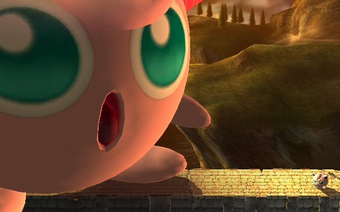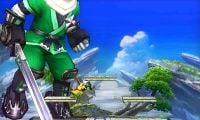Glitch: Difference between revisions
(Doesn't meaningfully contribute compared to the previous example.) |
(Removing section for soon-to-be new article, cleaning other stuff up, yadda yadda.) |
||
| Line 7: | Line 7: | ||
A '''glitch''' is an oversight of programming of a video game and how it may act in some circumstances. They alter [[gameplay]] by causing events or actions to occur that were not intended by the game's designers. The main reason for a glitch existing is that a specific situation resulting in unusual behaviour was never encountered during a game's testing, so the developers were unaware there was something that needed to be fixed. For example, the [[regenerating terrain glitch]] exists because the situation of "terrain appears around character using Final Smash" was not fully tested by the developers. The more complex a game is, the more likely glitches are to exist, simply due to the increased difficulty in testing every possible situation. | A '''glitch''' is an oversight of programming of a video game and how it may act in some circumstances. They alter [[gameplay]] by causing events or actions to occur that were not intended by the game's designers. The main reason for a glitch existing is that a specific situation resulting in unusual behaviour was never encountered during a game's testing, so the developers were unaware there was something that needed to be fixed. For example, the [[regenerating terrain glitch]] exists because the situation of "terrain appears around character using Final Smash" was not fully tested by the developers. The more complex a game is, the more likely glitches are to exist, simply due to the increased difficulty in testing every possible situation. | ||
The effects that glitches cause can vary. Glitches can be harmful, with such side effects as freezing the game, causing a level to be unplayable, or KOing a player for no apparent reason. Not all glitches, however, have negative side effects; some can allow the player to continue playing the game as usual, such as the [[Black hole glitch]], while others can merely be done for fun, such as the [[Name Entry glitch]] and all of its variations. Some can even be considered helpful, such as the [[regenerating terrain glitch]] on {{SSBB|Jigglypuff}} and {{SSBB|R.O.B.}} | |||
In competitive play, most glitches cannot be combined with a player's ordinary tactics | In competitive play, most glitches cannot be combined with a player's ordinary tactics. A majority of glitches require prerequisites that are unattainable in a tournament setting, such as items, Final Smashes, more than two players, or other, similar limitations; furthermore, many glitches simply have useless effects that would be of little benefit to players. | ||
When it comes to the legality of performable glitches however that can have a practical effect, they are generally allowed to be used, as they are perceived to add to the afflicted characters' [[metagame]]s, such as the {{SSB|Teleport}} in ''Smash 64'' and [[Yoyo glitch]] in ''Melee''. Glitches with only cosmetic effects are also usually allowed in competitive play, such as ''Melee's'' [[stock glitch]]. However, glitches that [[broken|break]] the game or otherwise cause matches to become unplayable for any party, such as by freezing opposing characters or making the user invincible, are universally banned from being used in tournaments; the [[Freeze glitch]] in ''Melee'' and the [[Infinite Dimensional Cape]] in ''Brawl'' are two such glitches that are banned in competitive ''Smash'', and use of either of these glitches can potentially lead to the disqualification of the offending party. | |||
[[File:SSB4 Giant Yoshi Glitch (Multiplayer).jpg|thumb|The Egg Lay glitch in the 3DS version of ''Smash 4'' that was ultimately patched out.]] | [[File:SSB4 Giant Yoshi Glitch (Multiplayer).jpg|thumb|The Egg Lay glitch in the 3DS version of ''Smash 4'' that was ultimately patched out.]] | ||
{{for3ds}} and {{forwiiu}} | If discovered, glitches can potentially be patched out in later revisions of the game, though this has only occurred in ''Melee'' and both versions of ''Smash 4''. In ''Melee'', glitches had the potential to be removed in [[List_of_regional_version_differences_(SSBM)|future revisions]] of the game if they had been previously noticed, such as the removal of the [[Shadow Glitch]] in all versions of ''Melee'' after 1.0. Both {{for3ds}} and {{forwiiu}} improved on this formula, by allowing both games to be potentially patched after release via downloads from the internet. Version [[List of updates (SSB4-3DS)/1.0.4 changelog|1.0.4]] for the 3DS version, for instance, fixed a glitch where characters could grow to immense sizes in [[Multi-Man Smash]] via the use of {{SSB4|Yoshi}}'s [[Egg Lay]]. | ||
[[Category:Game mechanics]] | [[Category:Game mechanics]] | ||
Revision as of 23:49, July 1, 2016

A glitch is an oversight of programming of a video game and how it may act in some circumstances. They alter gameplay by causing events or actions to occur that were not intended by the game's designers. The main reason for a glitch existing is that a specific situation resulting in unusual behaviour was never encountered during a game's testing, so the developers were unaware there was something that needed to be fixed. For example, the regenerating terrain glitch exists because the situation of "terrain appears around character using Final Smash" was not fully tested by the developers. The more complex a game is, the more likely glitches are to exist, simply due to the increased difficulty in testing every possible situation.
The effects that glitches cause can vary. Glitches can be harmful, with such side effects as freezing the game, causing a level to be unplayable, or KOing a player for no apparent reason. Not all glitches, however, have negative side effects; some can allow the player to continue playing the game as usual, such as the Black hole glitch, while others can merely be done for fun, such as the Name Entry glitch and all of its variations. Some can even be considered helpful, such as the regenerating terrain glitch on Jigglypuff and R.O.B.
In competitive play, most glitches cannot be combined with a player's ordinary tactics. A majority of glitches require prerequisites that are unattainable in a tournament setting, such as items, Final Smashes, more than two players, or other, similar limitations; furthermore, many glitches simply have useless effects that would be of little benefit to players.
When it comes to the legality of performable glitches however that can have a practical effect, they are generally allowed to be used, as they are perceived to add to the afflicted characters' metagames, such as the Teleport in Smash 64 and Yoyo glitch in Melee. Glitches with only cosmetic effects are also usually allowed in competitive play, such as Melee's stock glitch. However, glitches that break the game or otherwise cause matches to become unplayable for any party, such as by freezing opposing characters or making the user invincible, are universally banned from being used in tournaments; the Freeze glitch in Melee and the Infinite Dimensional Cape in Brawl are two such glitches that are banned in competitive Smash, and use of either of these glitches can potentially lead to the disqualification of the offending party.
If discovered, glitches can potentially be patched out in later revisions of the game, though this has only occurred in Melee and both versions of Smash 4. In Melee, glitches had the potential to be removed in future revisions of the game if they had been previously noticed, such as the removal of the Shadow Glitch in all versions of Melee after 1.0. Both Super Smash Bros. for Nintendo 3DS and Super Smash Bros. for Wii U improved on this formula, by allowing both games to be potentially patched after release via downloads from the internet. Version 1.0.4 for the 3DS version, for instance, fixed a glitch where characters could grow to immense sizes in Multi-Man Smash via the use of Yoshi's Egg Lay.
